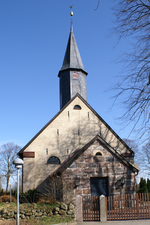Hedeby Viking Museum
Archaeological museums in GermanyArchaeological sites in GermanyDanish history stubsGerman history stubsGerman museum stubs ... and 5 more
History museums in GermanyHistory of Schleswig-HolsteinMuseums in Schleswig-HolsteinSchleswig-Holstein building and structure stubsViking Age museums

The Hedeby Viking Museum (Danish: Vikingemuseum Hedeby) (German: Wikinger Museum Haithabu) is a museum near the site of Hedeby, a former medieval city in Schleswig-Holstein, Germany focusing on the Viking Age history of the region. While the region is now in modern Germany, it was once the oldest city in Denmark until it was ceded in 1864. The museum features reconstructions of various Viking Age dwellings and ships and houses numerous artifacts discovered during the ongoing archaeological research of the area.
Excerpt from the Wikipedia article Hedeby Viking Museum (License: CC BY-SA 3.0, Authors, Images).Hedeby Viking Museum
Am Haddebyer Noor, Haddeby
Geographical coordinates (GPS) Address Phone number Website External links Nearby Places Show on map
Geographical coordinates (GPS)
| Latitude | Longitude |
|---|---|
| N 54.497 ° | E 9.5694 ° |
Address
Wikinger-Museum Haithabu
Am Haddebyer Noor 3
24866 Haddeby
Schleswig-Holstein, Germany
Open on Google Maps









